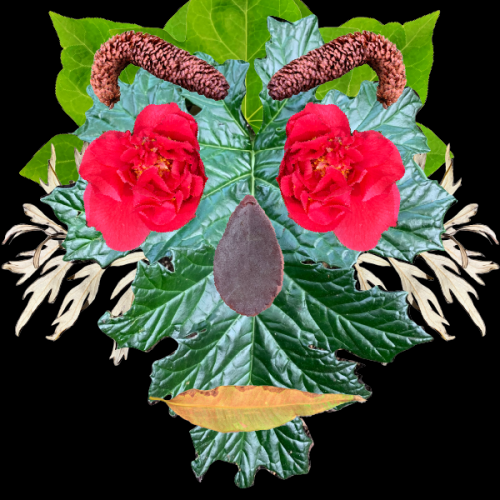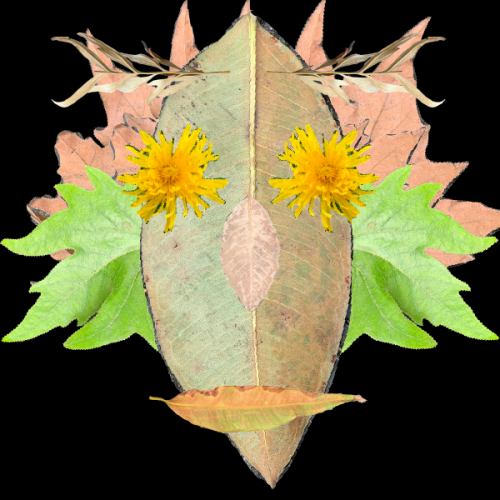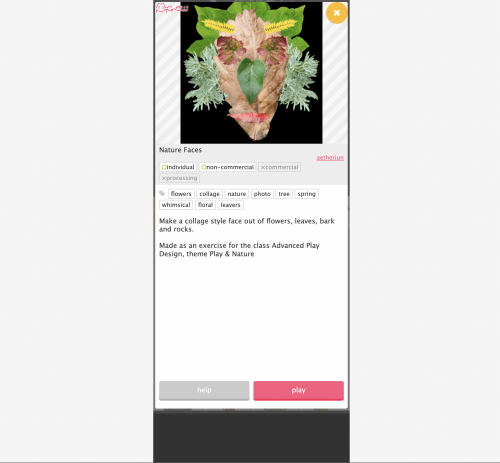
My response is avaliable online here
Theme:
My first instinct with the theme of Play and Nature was to create a response that somehow incorporated physical / natural materials, but I initially wasn't quite sure how to go about this. I considered making a 2D game in Unity, using photographs or scans of natural elements as the visual assets, but I struggled to come up with a concept or mechanics to work with.
My other idea was to make an avatar builder on picrew.me. Traditionally these avatar builders are used for anime style / illustrated works, but there are a couple more unconventional ones, like this 'Plasticine Picrew' that uses a combination of photos of plasticine sculptures, and illustrated elements. I thought I could make an image maker that used photographs of leaves, rocks and twigs, so the user could build a collage style face. This idea definitely took inspiration from Helen Kwok’s Found Faces Generator, as well as Holland Kerr and Amber Stacey’s Spontaneous Stop Motions from Nature video. I was also inspired by Soupe Opéra, a stop motion animation series that shows fruit and vegetables being dissembled and recombined to create a variety of animals and objects, as well as by depictions of The Green Man, a mythological figure that appears to be constructed from leaves.
Method :
My first step was to spend a bit of time researching picrew.me, and how the avatar builder worked for the creators. The website is in Japanese and the automatic in-browser translations weren’t reliable, but I was able to find a few forum posts and youtube videos that explained the process. I also made a quick sketch to work out what components I would need to construct the face.
My next step was to take my photographs. I walked from the studio to the Carlton Gardens, where I spent approximately an hour wandering around taking photos, before returning to campus. Initially I felt very self conscious, thinking about how strange I must look, stopping to take photos of leaves and twigs on the pavement, but after a while I got more comfortable, and actually really enjoyed the experience. I decided that I didn’t want to damage any of the plants, so if a leaf or flower had already fallen I would pick it up and move it to a better spot to photograph, otherwise I would do my best to take pictures as the plant was.
Then I had to remove the backgrounds from the images, so I would only have the subject as a transparent png. This was the most tedious / arduous part of the process. I tried using some automated tools like Adobe Express and remove.bg, but found their interfaces clunky, and they weren’t suited to processing a large amount of images. I resorted to using Photoshop and one of the studio Cintiq tablets, using the quick selection tool when the subject of the photo was distinct enough, and the lasso tool when it wasn’t, and removed the background from the images one by one.
I then sorted the images by features they could be used for; the base head, eyes, eyebrows, nose, mouth, ears and hair. Once sorted, I set about resizing and cropping the images so I could upload them to the relevant layer of the avatar builder.
Context :
For the gathering of the photographs and materials to construct my response, I was engaged in solitary play (Sutton-Smith, 2001), as well as paida, or free play (Callois, 1981). Though I was there to take photographs to use as assets in my response, my exploration of the gardens was loose and unstructured. I only stopped and returned to the studio when I was worried about getting a sunburn for staying out too much longer. I believe this was also an act of dérive (Debord, 1956), as I was drawn in by the features of the landscape around me, and my route around the gardens was winding and circuitous, driven by instinct rather than a plan.
My final response was inspired by collage, and the cut-up and reassembly techniques employed by Dadaist and Surrealists artists (Flanagan, 2009). There’s also a connection to the Theory of Loose Parts (Nichols, 1971), as the response encourages the user to assemble smaller components (in this case photographs of leaves, rocks and flowers), to create a larger image.
Reflection :
I’m very happy with how my response turned out. Up until I had the parts all imported into the avatar builder, I wasn’t sure if the faces would turn out the way I had been envisioning them, so I was ecstatic when I got to see the first face emerge from the generator.
I enjoyed the process of collecting the photographs to use as assets immensely. I don’t spend a lot of time outdoors, and when I do its usually when I’m either exercising or travelling, so to be outdoors in a more unstructured way felt very freeing.
The process of cutting out each image was incredibly dull, and felt a bit like wasted time even if I am happy with the final results, but I’m not sure of any way that the task could have been avoided, seeing as I found the automated tools didn’t give me results that I was happy with
References :
Caillois, R., 1961. “Man, Play and Games”. Chicago: University of Illinois Press.
Debord, G., 1958 “Theory of the Dérive,” Internationale Situationniste, #2.
Flanagan, M., 2009. “Critical Play”. Cambridge: MIT Press.
Nichols, S., 1971. “Theory of Loose Parts : How Not to Treat Children,” Landscape Architecture, vol 62, pp. 30–34.
Sutton-Smith, B., 2001. “The Ambiguity of Play”. Cambridge, Harvard University Press.
About This Work
By Eamonn Harte
Email Eamonn Harte
Published On: 09/10/2022




